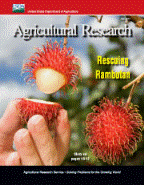United States Department of Agriculture: Agricultural Research Service, Lincoln, Nebraska

Agricultural Research Magazine
Date of this Version
5-2013
Document Type
Article
Citation
Agricultural Research May/June 2013.
Abstract
The world in 2050 is predicted to have 9 billion people, who will differ in almost every way but one: They will all need to eat on a daily basis.
Their nutritional needs will be similar, too. Nutrition means eating, eating means food, and food means agriculture. Many people speak of the increased food needed for 9 billion, but in reality, the increased need is for nutrition. Thus, the world of 2050 will force a melding of two disciplines that have diverged in recent years—agriculture and nutrition.
We need to change our focus. We need sustainable nutrition as much as sustainable agriculture, and this merger has implications for government policy, the food industry, and production agriculture, as well as for research by the Agricultural Research Service.
Feeding 9 billion people can be accomplished in several ways. One is to continue to produce and consume as we are presently doing, but to increase the scale. A second is to produce and consume more efficiently. A third is to change the nutritional needs—or perceived needs—of people.
U.S. agriculture after World War II seemed boundless, as farmland stretched from sea to shining sea. But in the intervening years, we built as if the land were limitless. Today, many market farms in the East are suburban home sites; many cattle ranches of the High Plains are resorts; and western agriculture is pressed by urban sprawl and limited water.
These issues are not unique to the United States. Europe reached our point perhaps 100 years ago, and the population explosion in Asia and Africa has saturated their land mass beyond the carrying capacity. One thing is clear: We will not feed 9 billion people by simply expanding the scale of the present system.
A second way to feed 9 billion is to produce more efficiently. One idea is to refine present means of production, but this is limited; for example, worldwide grain production increased by more than 3 percent from 1960 to 1970, but by less than 1 percent from 1990 to 2000. Certainly there will be more productionrelated discoveries in the future, but will they be enough to feed 9 billion? A new paradigm for “efficiency” is needed, and this is the reason for melding agriculture and nutrition.
Take, for example, our meat production processes, which many have criticized as an inefficient way of turning plants into too little nutrition and too much wasted fat. In fact, some demand an end to meat production and claim that it is an unethical approach to feeding the world. But is it?
What if “efficiency” emphasized taking advantage of an animal’s ability to utilize feeds unsuitable for humans? And what if we bred for leaner animals with “better” fats? Then animals would not compete with humans for food and, in fact, would convert these foodstuffs into nutritionally dense food with good fats and bioavailable protein, vitamins, and minerals. ARS is already doing this research, and a closer alliance of agriculture and nutrition will make the process more efficient and responsive.
Another example is research being done with micronutrient nutrition. The Green Revolution of the 1960s greatly reduced protein/calorie malnutrition of the world’s poor. But because grains are primarily carbohydrates, many people remained deficient in vitamins and minerals. What if we developed high-yielding grains that are also enriched in vitamins and minerals? Then a person’s nutrition would improve even if the food intake remained the same.
ARS is doing this as well. ARS has developed vitamin- and mineral-enriched rice and maize, and that has happened because of the partnership of the plant scientists with human nutritionists. But we will need many more such efforts to feed 9 billion. A third means to feed 9 billion is to change people’s nutritional needs. Agricultural demand is based on consumption, but more than half of the adult population in most developed nations is overweight or obese. If we substantially reduce obesity, then energy and nutrient needs in our country— and in virtually every other developed nation—will decrease. The concomitant decrease in the demand for food will leave more for the expanding population.
Included in
Agriculture Commons, Animal Sciences Commons, Food Science Commons, Plant Sciences Commons

